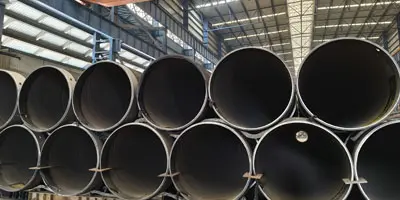ASTM A53 seamless and welded steel pipe is a general purpose pipe. A53 carbon steel pipe is designed for coiling, bending and flanging and is suitable for welding. The grade indicates certain chemical and mechanical properties that should be noted while selecting. A53 pipe is suitable for mechanical and pressure applications and also for general use in steam, water, gas and air lines, low pressure systems, structural applications, machinery components, bollards, casings, power plants, refineries, compressor stations, natural gas transmission and steam conduction.
Manufacturing Process
The manufacturing process varies with the specific type and grade of ASTM A53. The steel for seamless and welded pipes shall be manufactured by one or more of the following processes: open hearth, electric furnace or basic oxygen top blowing. The weld of Grade B electric resistance welded pipe shall be heat treated after welding. Following are the different types of ASTM A53 pipes.
ASTM A53 Steel Pipe Types
The ASTM A53 specification covers the following types and grades of A53 pipe:
Type F – Furnace Butt Welded, Continuous Welded Grade A
Benefits of ASTM A53 Steel Pipe
Pressure Tested
ASTM A53 pipe is pressure tested to allow the passage of liquids and gases.
Corrosion Resistance
Carbon steel pipes are corrosion resistant due to the addition of a lacquer coating, hot-dip galvanizing, or zinc coating. This allows builders to use smaller, thinner pipes even in acidic or extremely corrosive environments.
Impact Resistance
A53 steel pipes are highly resistant to vibration and shock.
High Tensile Strength
The tested steel pipes have a high tensile strength and can be safely used in extremely high pressure situations.
Economical and Effective
No matter how much pressure they need to withstand, carbon A53 steel pipes can be made much thinner than other types of pipes. This means they have a greater load-bearing capacity than other pipes.
Industry Applications
ASTM A53 and ASME SA53 are suitable for mechanical and pressure applications and for general use in steam, water, gas and air lines. It is suitable for welding and forming operations involving coiling, bending and flanging, subject to certain conditions. A53 covers seamless and welded, black and hot-dip galvanized nominal (average) wall pipe for coiling, bending, flanging and other special applications suitable for welding. Continuously welded pipe is not suitable for flanging. The purpose of the pipe should be stated in the order. A53 steel pipe is best suited for conveying air, water, steam and oil in low to medium pressure applications in the industrial sector. It is also commonly used as structural steel. Therefore, it can be used in almost any industry and environment where liquids and/or gases need to be conveyed. This includes oil and gas, buildings, housing and heavy equipment.
Chemical Requirements
|
|
|
Type S
(seamless)
|
|
Type E
|
|
Type F
|
|
|
|
|
(electric-
resistance welded)
|
|
(furnace-
welded pipe)
|
|
|
Grade A
|
Grade B
|
|
Grade A
|
Grade B
|
|
Grade A
|
|
Carbon max. %
|
0.25
|
0.30*
|
|
0.25
|
0.30*
|
|
0.3
|
|
Manganese %
|
0.95
|
1.2
|
|
0.95
|
1.2
|
|
1.2
|
|
Phosphorous, max. %
|
0.05
|
0.05
|
|
0.05
|
0.05
|
|
0.05
|
|
Sulfur, max. %
|
0.045
|
0.045
|
|
0.045
|
0.045
|
|
0.045
|
|
Copper, max.%
|
0.40
|
0.40
|
|
0.40
|
0.40
|
|
0.4
|
|
Nickel, max. %
|
0.40
|
0.40
|
|
0.40
|
0.40
|
|
0.4
|
|
Chromium, max. %
|
0.40
|
0.40
|
|
0.40
|
0.40
|
|
0.4
|
|
Molybdenum, max. %
|
0.15
|
0.15
|
|
0.15
|
0.15
|
|
0.15
|
|
Vanadium, max. %
|
0.08
|
0.08
|
|
0.08
|
0.08
|
|
0.08
|
Mechanical Properties & Tensile Requirements: A53 Steel Pipe
|
Physical Requirements - A53
|
|
Seamless & ERW
|
Grade A
|
Grade B
|
|
Tensile Strength (min. psi)
|
48,000
|
60,000
|
|
Yield Strength (min. psi)
|
30,000
|
35,000
|
|
Chemical Requirements - A53
|
|
Element
|
Grade A
|
Grade B
|
|
Carbon (max %)
|
0.250
|
0.300
|
|
Manganese (%)
|
0.950
|
1.200
|
|
Phosphorus (max %)
|
0.050
|
0.050
|
|
Sulfur (max %)
|
0.045
|
0.045
|






 English
English Español
Español بالعربية
بالعربية










 Phone :
Phone :  Whatsapp :
Whatsapp :  Email :
Email : 


